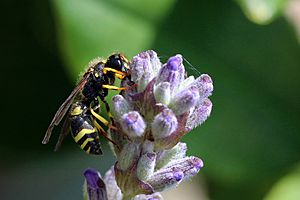European potter wasp facts for kids
Quick facts for kids European potter wasp |
|
|---|---|
 |
|
| Cumnor Hill, Oxford | |
| Scientific classification |
The European potter wasp (Ancistrocerus gazella) is a cool type of potter wasp. You might also hear it called the European tube wasp.
When these wasps are grown-ups, the female wasps are super busy! They collect up to 20 caterpillars for each nest they build. Each nest is like a tiny apartment with just one room. The baby wasps (called larvae) then eat these caterpillars inside the nest. The mom wasp seals the nest with mud to keep her babies safe.
Adult European potter wasps like to sip nectar from flowers. They also enjoy sweet honeydew made by tiny bugs called aphids. Don't worry about getting stung! Male wasps can't sting at all. And if a female wasp does sting you, it's usually not painful. You might spot these wasps on windows, flying around flowers, or looking for small cracks or holes to build their nests in.
Where They Live and What They Like
This amazing wasp originally comes from Europe. You can find them in many countries there, like Norway, Sweden, France, Germany, Italy, and Poland. They also live in England, Wales, and parts of Ireland. Plus, they're found in Morocco!
European potter wasps like to live in places with sandy and clay soil. This includes river banks, areas near the coast, parks, open forests, and even cities. They need these types of soil to build their special nests.
In 1987, these wasps made their way to Auckland, New Zealand. Now, they've spread quite a bit and can even be found far south in Otago!
Life Cycle of the Wasp
In late spring, the adult wasps wake up from their winter sleep. They fly around and eat nectar and pollen from plants like sea-holly, bramble, and thistles. This gives them energy!
After the wasps mate, the female wasps start looking for the perfect spot to build a nest. They often choose hollow plant stems, dead twigs with soft centers, or old tunnels made by other insects.
Inside these tubes, the female wasp builds several small rooms, one after another. She uses clay to make walls between each room.
- First, she lays a single egg in the first room.
- Then, she fills that room with several caterpillars that she has paralyzed (made unable to move).
- Finally, she seals the room with a clay plug.
- She repeats this process, making more rooms in the same way.
Each wasp egg hatches in just a few days. The baby wasp (larva) then spends about ten to twelve days eating all the caterpillars its mom left for it. After eating, the larva rests. Sometimes, if it's cold, it might take a long nap (called diapause) before changing.
After its rest, the larva spins a silky cocoon around itself. About two weeks later, a brand new adult wasp emerges! It moistens the clay plug of its room to soften it, then pushes its way out into the world.

